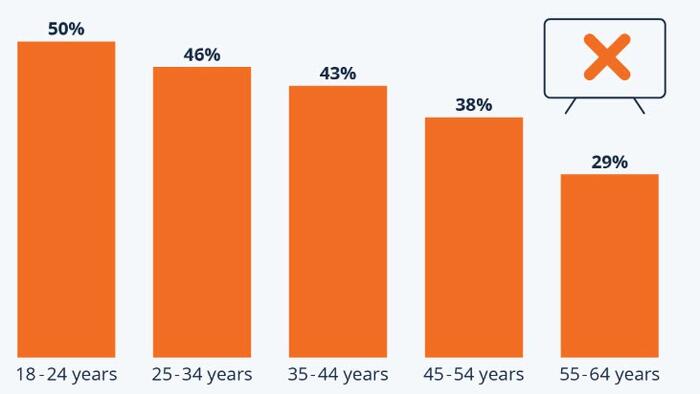As streaming services like Netflix, Amazon Prime Video, and Disney+ have exploded in popularity, traditional television is facing significant challenges in maintaining its status as a primary source of entertainment, distraction, and information. The shift towards on-demand viewing has dramatically altered consumer behavior, particularly among younger demographics. While the overall time spent watching television remains substantial, much of this consumption is driven by older generations. According to Statista analyst Felix Richter, Americans aged 65 and above watch an average of over 40 hours of traditional TV per week, while younger audiences, particularly those aged 18 to 34, average less than five hours per week. This stark contrast highlights a fundamental demographic divide in viewing habits, indicating that traditional TV may struggle to remain relevant in a rapidly evolving media landscape.
The trends regarding television viewership reveal a sharp decline in engagement among younger adults, with many opting to forgo traditional TV altogether. Statista Consumer Insights reports that approximately 50% of 18 to 24-year-olds in the U.S. say they do not engage with traditional television at all. This figure represents a significant cultural shift, as this generation increasingly leans on digital platforms for content, prioritizing flexibility and on-demand options that traditional TV fails to provide. In contrast, the same study highlights that only 29% of individuals aged 55 to 64 report the same disinterest in traditional TV, suggesting that as audiences grow older, they remain more attached to conventional forms of viewing.
Moreover, the issue for traditional television is compounded by the fact that younger generations are also increasingly drawn to alternative content formats, such as social media, YouTube, and streaming platforms. These channels not only offer a diverse range of programming tailored to specific interests but do so in a format that is easily accessible and often free or cheaper than traditional cable subscriptions. The influence of digital media has revamped the entertainment landscape, fostering a preference for bite-sized content that fits the lifestyle of today’s fast-paced, mobile-minded youth.
The implications for advertisers and the broader television industry are significant. As the audience shrinks, particularly among crucial demographics that tend to drive advertising revenue, the traditional TV model faces severe limitations. Nielsen’s data emphasizes that the viewership habits deeply affect advertising strategies, with brands increasingly reallocating budgets towards digital platforms where younger audiences are more active. The shift reflects a broader trend in media consumption where advertisers are compelled to follow their audiences, often at the expense of traditional TV networks.
The challenges presented by this evolving landscape also suggest potential avenues for traditional television networks to adapt. Some strategies may include partnerships with streaming services, production of original content aimed at younger audiences, and incorporating interactive and digital elements into programming. Programming that resonates with younger viewers—such as reality shows, short series, and engaging social media presence—can help bridge the gap between traditional and digital platforms.
In conclusion, while traditional television continues to hold a significant share of viewing time among older demographics, younger audiences are increasingly distancing themselves from conventional viewing. The stark contrasts in viewership trends indicate that traditional TV faces pressing challenges that require innovative solutions and adaptations to remain relevant in an era marked by the dominance of streaming and digital platforms. As the industry navigates this transformation, strategic shifts focused on audience engagement and leveraging emerging technologies could determine how traditional TV evolves to meet the expectations of today’s media consumers.

